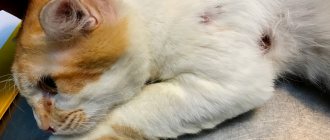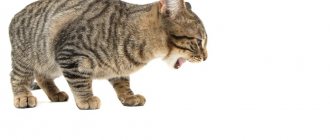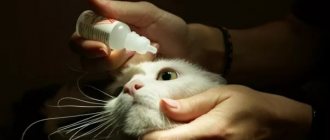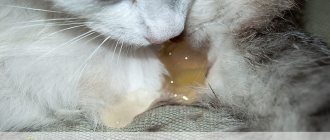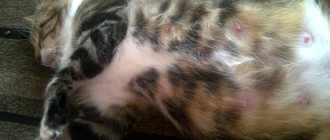Many cat owners, even if they have at least some experience, are afraid of their pet giving birth. You can often hear that the process of giving birth to babies almost certainly must be accompanied by some complications and difficulties. Fortunately, this is far from the case, and it is rarely necessary to really help the animal. Other breeders are concerned about discharge before childbirth: they also believe that discharge from the external genitalia must necessarily indicate something unpleasant and deadly... Is this really so, is it necessary to immediately contact a veterinarian?
Discharge at different stages of pregnancy
A cat's pregnancy lasts 9 weeks. It occurs in several stages:
- early – up to 3 weeks;
- fetal formation – up to 6 weeks;
- prenatal – up to 9 weeks.
A cat is expecting offspring.
Different secretions occur in each period. Kitties themselves are very clean and sometimes it’s hard to see her discharge. At the first stage of gestation, a light pink secretion may be released. During this period, the egg only attaches to the uterus. In the second stage of development, the transparent mucous part of the plug may separate as the cervix closes.
Important! If the discharge is bloody, then you should pay attention to this. They should not be confused with normal ones. There is a possible risk of miscarriage. A veterinarian's consultation is required.
At a later date, a secret may appear again, because the baby is due soon. Possible mucous scarlet secretion.
General information
Owners of such pets should strictly distinguish between the fact that there is discharge during gestation of kittens, and there are already prenatal departments. And depending on the time the mucus appears, different actions should be taken.
Cats, like humans, have a cervix. This part of the organ looks like a tube, and during the period when the fetus is not gestating, the neck is tightly compressed due to the work of the muscles. This is done so that various pathogenic microorganisms cannot penetrate into the uterus, because in any situation the internal cavity of the uterus must remain sterile. But during pregnancy, the cervix does not close completely, otherwise in the future it will not be able to relax enough to allow kittens to pass through it.
Therefore, during pregnancy, the cervix is closed by a mucous plug. It helps keep various bacteria, viruses and even air out. If this plug is damaged prematurely, it can lead to problems with the course of pregnancy. But about 5 days before the onset of labor, the plug breaks down on its own, and then brown or yellow mucus may begin to come out.
What kind of discharge can there be?
A cat's discharge may include:
- simple;
Cat discharge: bloody, white, purulent
Acceptable light pink secretion at the beginning of pregnancy as a result of egg implantation.
- blood;
A variant of a pathological process or threat of miscarriage. In a pregnant cat, bleeding can be fraught with complications. But they are quite natural during contractions and pushing.
- dirty yellow color;
In this case, you need to monitor the cat’s behavior and see how many days she behaves unnaturally. Such discharge in a pregnant cat is usually nothing serious. They are formed as a result of waste products of babies.
With additional symptoms, this color indicates the release of pus from the loop. Perhaps an inflammatory process has begun in the uterus. Urgent treatment with effective drugs or termination of pregnancy is necessary.
- white.
A normal situation during the period of fetal formation. Amniotic fluid fills the uterine cavity, and the excess flows out.
X-ray of a pregnant cat
Important! In any doubtful situation regarding the health of a pregnant cat, it is better to consult a specialist who will perform an ultrasound or x-ray diagnostics.
Diagnostic measures
If suspicious discharge appears in a cat before or before birth, it is necessary to take the pet to the veterinary clinic as soon as possible, where it will be examined by a veterinarian. The doctor will determine the nature of the discharge, whether it is pus, blood, ichor or transparent white mucus. Pink discharge without other inclusions in the early stages of pregnancy is considered normal; if the cat feels well and is not worried, then there is nothing to worry about. It’s another matter when there is bleeding from the genitals, with blood flowing or dripping constantly, the animal feels bad, is worried, or, conversely, is lethargic and passive. Then a referral is given to the following diagnostic methods:
- general blood and urine analysis;
- microbiological examination of secretions;
- Ultrasound.
Dangerous diseases
Brown discharge from a cat's eyes
Bloody and green discharge with a specific odor in a cat during pregnancy always indicates a pathological process, which is why additional symptoms appear. The reasons may be different: inflammation of the reproductive system, placental abruption, fetal death, etc. In some cases, this indicates diseases that require urgent treatment.
Vaginitis
Inflammation of the vagina. A diagnostic sign is that the cat begins to lick itself quite often, hiding the discharge. This makes diagnosing the disease difficult. A mild form can be cured with douching, a severe form can be treated with antibiotics.
Endometritis
Inflammation of the uterus. It is caused by intrauterine infection, as a result of which the animal can give birth to weakened or premature babies, who sometimes even die. Acute endometritis, if left untreated, leads to the death of the cat. And as a result of chronic endometritis, hydrometra can develop. The secreted secretion itself can be of different shades, any consistency and smell.
Hydrometer
Accumulation of fluid, exudate, and secretions of the uterine glands in the uterine cavity. As a result, the uterus swells. Scanty or spotting discharge is possible. It often develops against the background of chronic endometritis. Emergency treatment is necessary, otherwise the cat may die.
Hematometer
Occurs in case of uterine injury or inflammation. Blood accumulation occurs. During pregnancy, a cat will have bloody discharge from the uterine cavity.
Pyometra
An inflammatory disease of the uterus, as a result of which pus accumulates in it. Due to hormonal imbalance or pathogenic flora entering the cavity, endometritis begins to develop.
Schematic drawing of pyometra in a cat
Pyometra occurs in two forms:
- open. The resulting pus leaves the uterine cavity to the outside. The owner can easily detect such departments and begin urgent treatment;
- closed. With this form, pus accumulates inside, thereby inflating the uterus. Diagnosing the disease in this case is much more difficult. It is necessary to observe the behavior of a pregnant cat. Lethargic and apathetic state, fever, loss of appetite, profuse thirst, the cat often begins to lick itself, often urinates, while breathing is heavy.
What to do if a pregnant cat is bleeding?
Bloody discharge during pregnancy indicates the development of pathology. Bleeding can be caused by placental abruption, kitten death, or uterine rupture.
If the event occurred before the 63rd day of pregnancy, and it is determined that the offspring has died, measures are taken to save the cat’s life, a cesarean section is performed.
In this case, castration is recommended, since there is a high probability of purulent damage to the reproductive organs.
When bleeding after the onset of contractions continues for more than 10 minutes, and blood loss is more than 2 tablespoons, you need to immediately take the cat to the clinic or call a veterinarian at home. If the birth went well, you should not be afraid of the release of blood clots mixed with mucus. Cleansing can last about two days.
When any discharge appears, you should call a veterinarian
At the very beginning of pregnancy, immediately after mating, light pink discharge is possible. This is due to the formation of a mucus plug, part of which comes out. This is a homogeneous transparent mucus without a specific odor. This is a normal situation, there is no need to panic.
Necessarily! There are discharges, if detected, you should immediately contact a specialist.
Bloody, yellow, green, with brown clots, discharge with a specific odor - these are the symptoms that you need to pay attention to. May be accompanied by fever, restless behavior, lack of appetite, frequent drinking and urination, and cramping pain.
Important! Do not confuse blood in a cat before birth with pathological discharge.
Three days before delivery, the mucus plug comes off.
There may be stool coming out of the anus. There are completely different reasons and a different treatment.
Mr. Cat Explains: Safe Slime Formations
The appearance of pink discharge may be noted after mating, this is normal.
You should carefully observe the abundance of mucous formations; if a foreign odor develops or blood is separated, you need to seek help from a veterinary hospital.
Until the cervix closes completely, unfertilized eggs can be seen leaving the genitals in the form of a brown discharge. This is considered the norm, as it indicates the mummification of dead, decomposing embryos, which occurs with complete sterility in the womb. If an organ is infected, an inflammatory process begins.
Preventive measures
Some discharge is a variant of a normal physiological process. To avoid the addition of pathological flora and subsequent inflammation, you need to follow a number of recommendations:
- strictly observe antiseptic conditions during childbirth;
- regular health checks with a veterinarian;
- Ultrasound of the uterus should be done periodically;
- when mating, carefully check the cat for the absence of genitourinary infections;
- do not postpone a visit to a specialist if you notice a different cat behavior with a specific secretion and smell.
Cat pregnancy is a process during which it is worth paying close attention to your pet. Unhealthy discharge in a pregnant cat is a reason to immediately contact a veterinarian. Timely treatment will help maintain the health of the pet and the life of the kittens in the womb.
Video
Prevention
In order for the process of bearing offspring in your animal to go smoothly, it is important to carry out preventive measures in a timely manner. Moreover, it is better to carry out some of them not at the moment when mating occurs, but throughout the entire life of the animal.
Monitor the animal’s health, get all the necessary vaccinations on time and select the right food, taking into account all the parameters. It would also be a good idea to have periodic checkups with a veterinarian.
After mating, you should carefully monitor the condition of the animal and pay attention to even the smallest changes.
- All the veterinarian's instructions must be followed very carefully.
- During pregnancy, you should protect your pet from cold, drafts and dampness.
- For mating, you should choose a healthy partner who has all the necessary vaccinations.
It is important that mucous discharge can also appear in a sterilized cat a short time after surgery. They have a slimy consistency and yellow color, but do not have a strong odor. If such discharge does not stop for a long time, then you should show your pet to a veterinarian, as inflammatory processes are likely to develop.
Proper care and following all doctor’s recommendations will help your cat have a normal pregnancy and give birth to healthy kittens. It is important for the owner only to pay attention to the condition of the pet, and everything else will happen by itself.
This article has been checked and approved by a veterinarian. Knyazeva Anna Vladimirovna, veterinarian in private practice, Moscow. more about the expert.
(you can vote for the article)
Tags: cat pregnancy, cat discharge, cat
- Related Posts
- Umbilical cord in kittens: how to help a cat separate it?
- The cat meows for no reason: what to do?
- A cat is dying: when should you put an old cat to sleep?
Hormones prolactin and lactation hormone
The hormone prolactin is a “maternal behavior” hormone and a lactation hormone.
Stages of childbirth in detail.
Childbirth is divided into 3 stages, each stage has its own time interval.
The intervals and duration of labor are unpredictable, and past births are not an indicator. One time an animal can give birth in a couple of hours, another time the birth will last almost a day and both options can be the norm.
Stage 1 – harbingers of labor.
This is the most painful stage for the animal and the owner. Behavior changes as the uterus contracts, but we do not see this in the abdomen. The dog (cat) is breathing heavily and digging or making a nest. The period can take up to a day. To confirm the onset of labor in dogs, a progesterone test can be done. Its decrease confirms the onset of labor.
Exception: In cats, progesterone is also produced by the placenta, so the drop in progesterone will not be as significant as in dogs. A strong decrease in cats occurs only the day after birth.
Similarly, in the case of “single puppy/kitten syndrome”, one fetus may not cause such a cascade of reactions, as a result of which pregnancy may be delayed. And there is no decrease in temperature, since progesterone does not drop and labor does not begin for a long time.
Pathologies during pregnancy and childbirth
Bloody black/green discharge during childbirth without any signs of labor is a life-threatening condition for the female.
Possible reasons:
- primary uterine laxity in combination with the death of at least one embryo and separation of the placenta
- death of embryos in the middle or late stages of pregnancy and their blood mummification
Postpartum discharge from the loop (lochia) is normal, but monitoring it is extremely important. Excretion continues from 7 to 30 days, gradually changing color to lighter and decreasing in volume.
In the absence of complications, at first the lochia have a greenish color (the first day), then they become light pink. If they are odorless and not accompanied by high fever, indigestion and other painful symptoms, then there is no reason to worry.
Bloody discharge, or a change in the color of lochia (dirty green, brown) with an unpleasant odor, accompanied by tension in the abdominal wall, symptoms of intoxication, and high temperature should be a reason for an urgent call to a veterinary gynecologist.
Foul-smelling red purulent clots after childbirth are signs of postpartum metritis, which developed as a result of bacteria entering the uterus during childbirth, auxiliary manipulations, retained fetal membranes, and miscarriage.
The female shows signs of intoxication, she is depressed and refuses to eat. Body temperature is high, as evidenced by a hot, dry nose and heavy breathing.
As a result of cessation of lactation, babies cry from hunger and cold. Possible maternal death.
